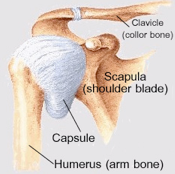Frozen Shoulder (Adhesive Capsulitis)
The shoulder is a ball and socket joint. The ball (head of the humerus) sits in the socket (the glenoid fossa).
 The shoulder joint is enclosed by soft tissue which surrounds the shoulder like a plastic bag; this soft-tissue “bag” is known as the joint capsule.
The shoulder joint is enclosed by soft tissue which surrounds the shoulder like a plastic bag; this soft-tissue “bag” is known as the joint capsule.
Adhesive capsulitis, also known as frozen shoulder, occurs when the joint capsule becomes inflamed and ultimately thickened.
The cause of adhesive capsulitis is not fully understood. Adhesive capsulitis is much more common in patients with a history of diabetes. Other risk factors include: hypothyroidism, hyperthyroidism, Parkinson’s disease, and cardiac disease or surgery. It most commonly affects people between the ages of 40-60 years.
Signs & Symptoms:
Adhesive capsulitis manifests as pain and/or significant stiffness and limited range of motion in the shoulder joint. The disease process normally goes through three phases. Phase 1 is the freezing phase, in which patients experience the onset of severe shoulder pain with no obvious inciting cause. As the pain worsens, the shoulder begins to develop stiffness and limitation in range of motion Phase 2 is the freezing phase in which the pain typically subsides but limitations in shoulder range of motion persist or worsen. Phase 3 is the thawing phase in which the range of motion gradually improves back to normal.
Adhesive capsulitis is typically a self-limiting condition. In other words, eventually the condition will run its course and pain will decrease and range of motion will return to normal. However, this process may take up to 2 years to fully resolve.
Diagnosis:
The diagnosis of shoulder frozen shoulder is typically made by the patient’s history and the findings on physical examination. X-rays are frequently obtained to rule out other possible sources of pain and stiffness. If there is a diagnostic dilemma, an MRI scan may be obtained; this typically will show significant thickening of the shoulder joint capsule.
Treatment:
Because of the self-limited nature of the condition, the treatment of adhesive capsulitis is typically non-operative initially. The precise treatment depends upon the phase of the condition when the diagnosis is made. If adhesive capsulitis is diagnosed during the painful phase, a steroid injection given into the shoulder joint can be very effective at decreasing inflammation and limiting thickening and scarring of the joint capsule. This injection is typically combined with icing, anti-inflammatory medications, and a course of physical therapy.
 If adhesive capsulitis is not diagnosed until the frozen phase, the steroid injection is less likely to be effective in preventing thickening and scarring of the joint capsule. In this scenario treatment focuses on trying to regain range of motion. Therefore typically a course of physical therapy combined with an aggressive home exercise program to work on shoulder range of motion exercises is recommended. Rarely do patients present for evaluation in the thawing phase because patients typically have significant improvement by the time they reach this phase. Treatment in the thawing phase again focuses on improving range of motion through physical therapy and a home exercise program.
If adhesive capsulitis is not diagnosed until the frozen phase, the steroid injection is less likely to be effective in preventing thickening and scarring of the joint capsule. In this scenario treatment focuses on trying to regain range of motion. Therefore typically a course of physical therapy combined with an aggressive home exercise program to work on shoulder range of motion exercises is recommended. Rarely do patients present for evaluation in the thawing phase because patients typically have significant improvement by the time they reach this phase. Treatment in the thawing phase again focuses on improving range of motion through physical therapy and a home exercise program.
Surgical treatment is considered in patients who fail to improve despite several months of non-surgical treatment. Surgical options include both invasive and non-invasive measures. One option is to proceed with a manipulation of the shoulder joint with the patient under anesthesia. During this procedure, the patient is anesthetized and the shoulder joint is aggressively manipulated to break up scar tissue and improve range of motion, but no actual incisions are created. Alternatively a manipulation under anesthesia can also be combined with a minimally invasive arthroscopic procedure known as a capsular release; in this procedure scarring of the capsule is cut and removed using arthroscopic techniques.
